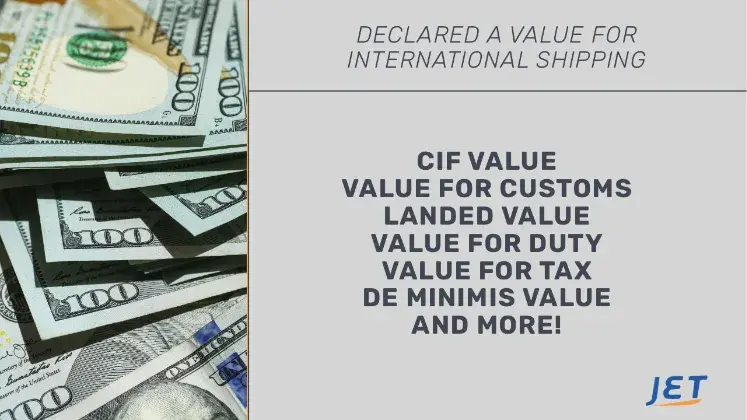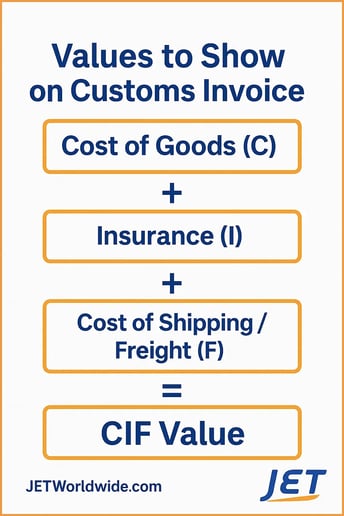
How to Declare Customs Value for International Shipments
When shipping internationally, a common question we get is: “What value should we declare?” The declared value (along with HS classification) is the key factor in import duty assessment. Over-declaring leads to needless cost, while under-declaring risks fines, delays, or legal action.
What You’ll Learn
- Transaction value and alternative valuation methods
- How to approach valuation for online orders, wholesale vs single units
- How to estimate duties and landed cost (calculator below)
Key Factors in Duty Assessment
Customs agencies typically use three elements to assess import duty:
- Declared value of the goods
- Country of origin
- Customs tariff classification (HS Code) — Learn more
For more on Canadian non-resident import rules, see this guide.
Transaction Value: The Primary Method
The transaction value is the amount paid (or payable) for the goods when sold for export. It’s the starting point in almost all countries’ valuation rules.
Even when there’s no direct sale (e.g. free samples, warranty replacements), you may still need to estimate a value. Many of our clients ship commercial samples or spare parts under that scenario.
What can be included in transaction value?
- Packing cost (if borne by the buyer)
- Commissions (selling commission by buyer)
- Assist (value of materials, tooling, etc.)
- Royalties or license fees required as sale conditions
- Proceeds of resale, disposal, or use accruing to the seller
Note: In the U.S., transportation costs are not included in transaction value.
Partner with Jet Worldwide
Our experts provide personalized support to ensure your shipments are classified correctly, delivered on time, and fully compliant.
Request a Quote Talk to an Expert
Export vs Import Valuation Differences
For export declarations, the declared value usually excludes shipping. But for import duty, many countries (e.g. Canada) require inclusion of transport and insurance costs (i.e. CIF value) in the duty base.
First Sale Rule (U.S. Imports for E-commerce)
The U.S. “First Sale Rule” allows, in limited conditions, declaring the manufacturer’s cost rather than full retail cost. But meeting those conditions is challenging, and the burden of proof is high. Learn more.
Key conditions often include:
- U.S. entity acting as importer of record
- Transaction done between seller and that entity
- Resale or final sale to consumer post-importation
- Proper documentation and legal support for the valuation
Intrinsic Value and Consignment Concepts
“Intrinsic value” refers to the price of goods when sold for export, excluding shipping or insurance unless bundled. If shipping is bundled, you must itemize it separately.
Consignment vs Goods
A consignment occurs when goods are shipped from one consignor to one consignee under the same waybill. Even then, each consigned unit may need a proper declared value.
See also the Canadian non-resident import rules above.
Alternative Valuation Methods
If you're unable to use the transaction value, customs allows fallback methods in hierarchical order:
- Transaction value of identical goods
- Transaction value of similar goods
- Deductive value (resale price minus deductions)
- Computed value (cost + processing + packing + profit)
- Fallback method (adjusted method from prior options)
These methods are used only in exceptional cases—such as high-value disputes or missing documentation.
CIF Value: What It Means & When It Applies
CIF = Cost, Insurance & Freight. For many customs authorities, the “value for duty” is based on CIF (goods + transport + insurance). For example, goods worth $1,000 with $200 shipping insurance would have CIF = $1,200.
However, some countries calculate duty on FOB value (goods only). Always check local customs rules. When using CIF, we recommend itemizing goods, insurance and freight on the invoice.
U.S. Treatment of CIF Value
The U.S. typically uses the value of goods only (plus allowable adjustments). Shipping and insurance are not themselves considered part of the value, but certain packing, assist, royalties, etc., may still be included.

International Valuation Rules & Incoterms
International customs adopt hierarchical valuation rules, usually beginning with transaction value. But local deviations exist (for example, UK, Canada, EU). Always consult the specific country’s rules. UK valuation rules are one such reference.
Duty assessments also depend on Incoterms. Under CIF terms, the seller includes freight & insurance, which may influence the duty base. More on Incoterms.
Declaration for Non-Resident Importers to Canada
Generally, the proper declared value is the transaction value to the Canadian purchaser—not the value between foreign parties. More details.
Inter-company / Related-Party Transactions
Related-party sales must be carefully evaluated, as customs may reject undervalued pricing. Transfer pricing, documentation, and proof will be scrutinized.
Wholesale vs Retail Import Valuation: Practical Impact
Retail e-commerce shipments are often disadvantaged in duty assessment. For example, a wholesale import of 1,000 units at $5 each is declared at $5 per unit. But the same item sold at retail at $30 per unit would be charged on $30. That difference can significantly impact landed cost.
Some tradeoffs to consider between Traditional Retail Logistics (TRL) vs Direct Online Shipping (DOS):
- Warehousing in destination country (TRL) vs direct import (DOS)
- Ocean + consolidation vs direct air freight (TRL vs DOS)
- Duty-free thresholds and exemptions (favourable to DOS in some markets)
- Differences in declared value base (retail vs wholesale)
Other Helpful Resources
Frequently Asked Questions
What happens if I undervalue my goods?
Customs may penalize you, delay clearance, or even seize goods—especially during audits. Always declare a defensible value with complete documentation to avoid penalties and shipment holds.
Do shipping costs always count toward duty?
Not always. Some countries include shipping and insurance costs (CIF basis), while others—like the United States—exclude them. Always verify the local customs valuation basis before declaring.
Can I use the First Sale Rule in all countries?
No. The “First Sale Rule” applies mainly to U.S. imports and only under strict conditions with comprehensive documentation showing a bona-fide sale for export to the U.S.
How can I estimate my landed cost before shipping?
You can use Jet Worldwide’s Duty & Landed Cost Estimator above to approximate duties and taxes based on value, weight, and shipment size.
What’s the difference between CIF Value and Value for Duty?
“CIF Value” includes the cost of goods, insurance, and freight. “Value for Duty” is the figure customs uses to calculate import duties and may or may not include freight, depending on local rules.
What’s the safest way to ensure compliance?
Maintain transparent commercial invoices, include HS codes, use realistic valuations, and consult with your customs broker or Jet Worldwide for pre-clearance validation.






